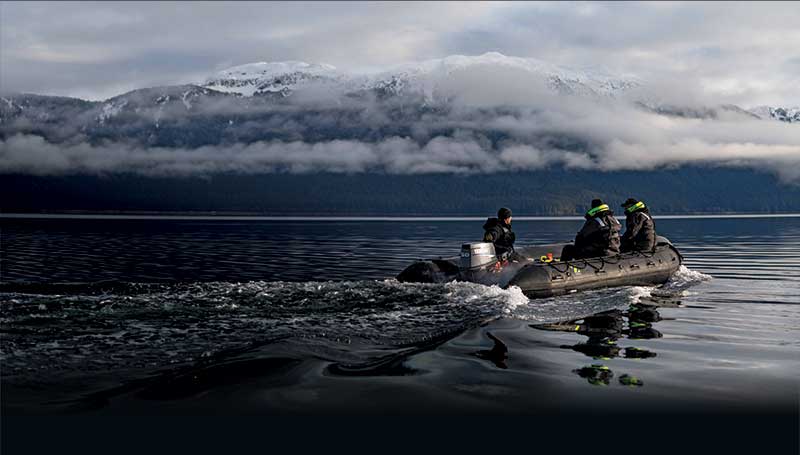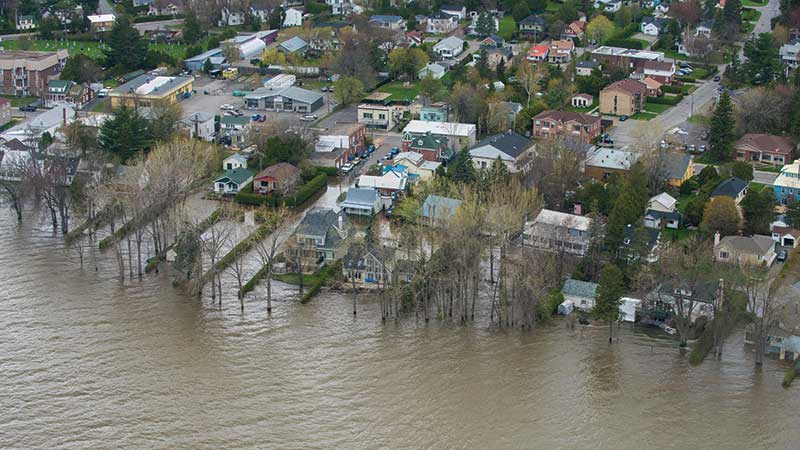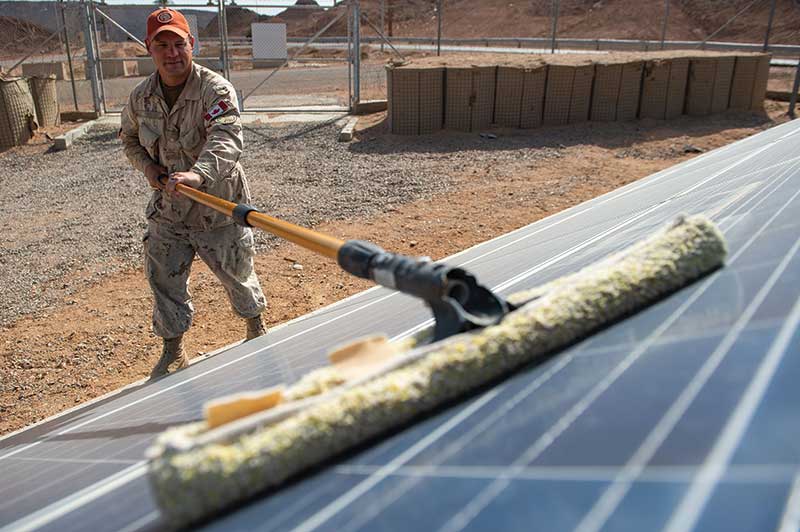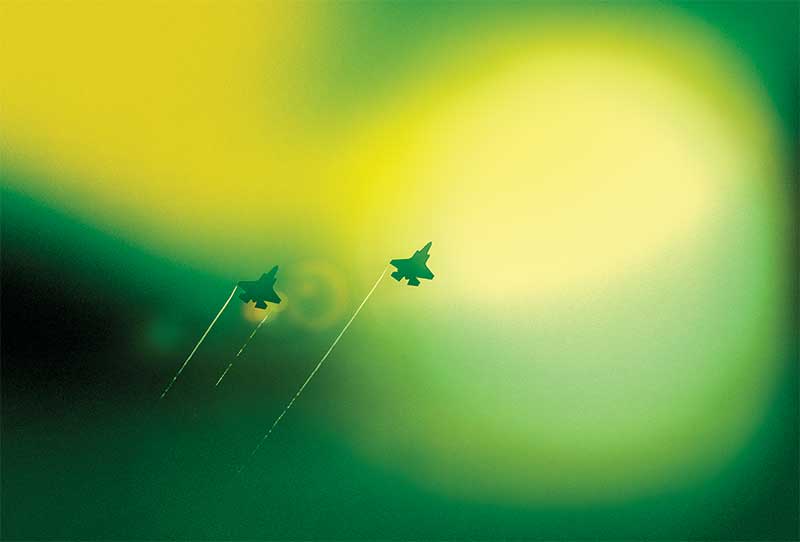Canada’s military and armed forces around the world are taking steps to fight climate change by reducing their emissions

HMCS Brandon’s fleet diving unit prepares to deploy a remote environmental monitoring device near Juneau, Alaska, in early 2022. [Cpl. Hugo Monpetit/CAF Combat Camera/20220304IS0001D003]
It is, as the old saying goes, hard to drain the swamp when you’re up to your neck in alligators.
That is the metaphorical challenge facing NATO members, including Canada, in maintaining a robust defence against current military menaces while dealing with a persistent and growing peril—and one to which they themselves contribute: global warming.
Climate change poses many threats to international peace: conflicts fuelled by water scarcity and famine; climate refugees and territorial aggression; new threats to sovereignty (such as that facing Canada as Arctic sea ice melts); humanitarian aid in response to climate-related disasters such as severe floods, massive wildfires; and more on a growing list.

Climate change is causing record-setting floods, such as the one in Rigaud, Que., in the spring of 2017. [Cpl. Myki Poirier-Joyal/CAF Combat Camera/SJ03-2017-0142-08 ]
At the same time, fossil-fuel guzzling military jets, ships, vehicles and tens of thousands of energy-hungry armed forces’ installations around the world are themselves helping fuel climate change.
The world’s militaries produce about six per cent of global greenhouse gas emissions, according to calculations by Scientists for Global Responsibility. NATO wants to help reduce that.
“We cannot compromise our military effectiveness,” said NATO Secretary General Jens Stoltenberg at the alliance’s 2022 summit. “NATO is about preserving peace through a credible deterrence and defence. Nothing is more important. If we fail to preserve peace, we also fail to fight climate change.
“At the same time,” he said, “we also have a responsibility to reduce emissions.”
NATO has committed to cut its greenhouse gas emissions by at least 45 per cent of 2019 levels by 2030 and to be carbon neutral by 2050. It’s also establishing the NATO Climate Change and Centre of Excellence, which will be located in Montreal and is slated to open in 2023. It will have a dual focus—advising its members on threats to global security caused by climate change, as well as how to reduce the impact of military activity on global warming.
Military capability cannot be compromised. However, DND also recognizes the requirement to power our forces should be done as sustainably as possible
For two decades after the planet’s initial international climate action agreements were struck, countries did not have to report military tactical emissions to the agencies co-ordinating the world’s response to global warming, ostensibly for national security reasons. Such reporting has now been voluntary since 2015.
Today, even the military recognizes that what gets counted, counts.
“This is vital, because only what gets measured can get cut,” said Stoltenberg.
NATO has asked its 30 member states to set their own reduction targets for military emissions. Canada is doing so now.

Canada’s MV Asterix, a temporary supply vessel while the navy awaits its new and greener support ships, tops up fuel for the USS Ross in 2020.[S1 Louis-Philippe Dubé/CAF Combat Camera/20201014GD01901D097]
While the Department of National Defence’s non-combat operations have long been counted in federal emissions reduction targets, the emissions of the national safety and security fleets, the Coast Guard, the RCMP and the “armed” part of the Canadian Armed Forces, have not.
In 2022, the national safety and security fleets were added to the federal Greening Government Strategy, which calls for net-zero emissions by 2050—when Canada is intent on producing no more greenhouse gases than can be captured or reabsorbed by oceans and forests.
“Military capability cannot be compromised,” said Jessica Lamirande, DND/CAF spokesperson. “However, DND also recognizes the requirement to power our forces should be done as sustainably as possible without impacting safety and security.”
DND and CAF infrastructure, light-duty vehicle fleets and national safety and security emissions accounted for about 59 per cent of federal government emissions in 2019-2020.
“Consequently, we have a critical role to play in helping the government of Canada meet its climate change objectives,” said Lamirande.
Published in 2020, DND’s “Defence Energy and Environment Strategy” addresses ways to cut emissions, reduce energy use and improve energy efficiency across the board. DND committed to reducing emissions from its buildings and light-duty vehicle fleet to 40 per cent of 2005 levels by 2030 and is on track to reach that goal five years sooner.
In 2021, 34 per cent of DND and CAF non-tactical light-duty vehicles were electric or gas-electric hybrids, and nearly three-quarters of the electricity used on military bases came from renewable sources—the latter is expected to reach 100 per cent by 2025.
Heating buildings accounts for much of the federal government’s emissions, and DND is responsible for about 21,000 structures, some in cold and remote locations.
The department is assessing energy use at bases, with a goal of maximizing the efficiency of heating and cooling systems. It will also use automatic lighting in new buildings and is retrofitting older buildings similarly. And electricity on bases will come from renewable sources.
DND’s first net-zero building, at the Explosive Ordnance Disposal Training Facility in Gagetown, N.B., can operate off-grid. It’s powered by a solar field and a battery storage system and uses geothermal heating. Meanwhile, upgrading 81 buildings at 2nd Canadian Division Support Base in Valcartier, Que., “will cut over one-quarter of Valcartier’s emissions,” said Defence Minister Anita Anand in 2022.
Since 2015, DND has spent $370 million improving facilities in 13 locations, changes expected to reduce emissions by more than 64,000 tonnes annually. (By comparison, Canada produced 672 megatonnes (Mt) of greenhouse gas emissions in 2020, down from 740 Mt in 2018).

In Egypt in 2019, Sergeant Daryl Preece removes dust from a solar panel to increase its efficiency.[Sgt. Vincent Carbonneau/CAF Combat Camera/IS02-2019-0010-003]
Making vehicles and buildings more energy efficient and self-sufficient is a start, but reducing the carbon impact of activities at the pointy end of the stick—the “armed” part of the Canadian Armed Forces—is a bigger challenge.
Of 844 kilotonnes (kt) of carbon dioxide emissions produced by the national safety and security fleet in 2020-21, DND was the source of 592 kt, 84 per cent from aircraft, 15 per cent from marine vessels and one per cent from tactical land vehicles (a statistic likely to change if Canada were to partake in another combat mission such as the war in Afghanistan).
Getting that to net-zero by 2050 will be some battle itself.
The Royal Canadian Air Force has more than 430 aircraft, including jet fighters and helicopters. The navy operates about 40 vessels, including four submarines, a dozen frigates, a dozen coastal defence vessels, plus patrol vessels. The army’s tactical vehicles include tanks, personnel carriers, reconnaissance and patrol vehicles and multipurpose Humvees. A Humvee consumes about a litre and a half of gas every five kilometres.
Until recently, operational readiness and safety trumped environmental concerns when ordering replacements, but emissions are now incorporated in planning for a hotter future.
Most of DND’s safety and security emissions “come from the operation of air and sea platforms,” Lamirande said, adding “sustainable and renewable fuels represent the largest opportunity in the near term” for reductions.
Many Canadian aircraft currently in service can operate on a blend of conventional and sustainable aviation fuel (SAF), and Canada is committed to buy more than 300 million litres of SAF, or low-carbon-intensity fuels, by 2030-31—if it can. There’s a shortage.
For supplies of alternative fuels to increase, there need to be more feedstock sources, which include algae, food waste, vegetable oils and fats, and large-scale production facilities need to be built and a distribution system developed.
Belonging to an alliance will be helpful.
“Working closely with our allies will allow us to enhance collective buying power, thereby driving innovations in the defence industry,” said Lamirande.
Canada, for instance, may not buy enough aviation fuel to spur development of alternative fuel feedstock, manufacturing and delivery systems, but supplying all 30 NATO members, including the United States, which has the world’s largest military air fleet, would be a powerful incentive for such development.
Another problem is that Canadian vessels and equipment have long lives. The destroyer HMCS Athabaskan served from 1972 to 2017. Canada’s Buffalo aircraft served for five decades.
“The long development times and service lives of many types of military equipment make it particularly critical that suppliers are provided with efficiency guidance far ahead of emissions target dates,” says the Conflict and Environment Observatory in its 2022 report on military greenhouse gas emission reporting.
The problem is, much of the equipment in the process of being ordered will still be in service in 2050, when Canada aims to achieve net-zero emissions.
“Having a greener fleet must, of course, start with procuring a greener fleet,” said Lamirande.
Energy and fuel efficiency are now factors considered (though not mandatory) when ordering replacement craft and vehicles. The CAF is in the process of building 15 ships to replace navy destroyers and frigates, 28 helicopters and 88 fighter jets to replace the aging fleet of CF-18 Hornets. The Canadian army, meanwhile, is on the brink of replacing its fleet of Humvees with 55-75 high-mobility multipurpose wheeled vehicles.
There have already been technological advances to increase military fuel efficiency. New materials used in military vehicles are lighter, but just as strong as the parts they’re replacing; lighter vehicles greatly improve fuel efficiency. And efficient fuel cells that convert hydrogen gas into electric power for hybrid vehicles have been developed. Plus, alternative fuels are starting to be used to replace or augment petroleum-based gas for aircraft and naval vessels.
As technology improves and research breakthroughs accumulate, there will be more and more options for replacements and retrofitting. The United States, a strong driver of military research and development, is banking on it.
The U.S. has the world’s third largest military force with nearly 1.4 million active personnel; it has the largest air force by a wide margin and its ground forces and navy are among the world’s largest in size. And it has a large and well-established military research community, as do its allies.
In 2021, it identified climate change as a critical threat to U.S. military operations.
“We face all kinds of threats in our line of work,” said U.S. Secretary of the Army Christine Wormuth, “but few of them truly deserve to be called existential. The climate crisis does.”
The U.S. army intends to have a fleet of hybrid-drive tactical vehicles by 2035, and by 2050 it wants to have rechargeable electric combat vehicles. The U.S. navy is aiming for net-zero emissions by 2050, turning from fossil fuels to electric power, better batteries and retrofitting ships’ engines and storage tanks for alternative fuel use.
Canada and the rest of NATO can only benefit from the advances of the Americans.
“NATO can help set the gold standard on understanding, adapting to and mitigating the security impacts of climate change,” said Marilyne Guèvremont, spokesperson for Global Affairs Canada, which with DND proposed the NATO Climate Change and Security Centre of Excellence in 2021.
The centre will help Canada and its other members work co-operatively to find and share best practices. It’s becoming clear that fighting climate change will require global collaboration.

Heat waves and exhaust emissions pour off a CF-18. The contrails can stay in the atmosphere for decades. [Stephen J. Thorne/Legion Magazine]
Plane Power
There is no doubt about it: aviation is contributing to global warming.
Emissions from aircraft fuel are responsible for at least 3.5 per cent of all factors that cause climate change—and that’s not counting military aircraft, the emissions of which are not reported by many countries.
And military aircraft are fuel hogs, particularly combat aircraft that reach supersonic speeds, which need more thrust that requires more fuel. In 2021, the global military fleet exceeded 53,000 aircraft, more than twice the civilian fleet. And the U.S. air force, the world’s largest, uses about nine billion litres of fuel annually.
But climate impact from armed aviation isn’t due to fuel alone. Military jets fly higher than passenger and cargo aircraft, leaving contrails that disperse in the high atmosphere.
“Flying is fuel intensive and its climatic impact is generally about twice the CO2 emitted alone,” writes Yves Engler in Stand on Guard for Whom? A People’s History of the Canadian Military.
Contrails form a thin layer of cloud that acts like a blanket in the atmosphere, preventing heat from radiating into space. The layer stays in the atmosphere for decades.
But there’s no quick fix to provide alternate energy to power high flight.
“Sustainable and renewable fuels represent the largest opportunity in the near term” for reductions.
Civilian airlines are gravitating to electric power, but the technology is still at a prototype stage, limited so far to small planes travelling short distances. Due to weight of the batteries (about five tonnes) these early electric planes carry a handful of passengers and fly about 200 kilometres between charges. Gas-electric hybrid technology can quadruple that distance.
Still, civilian aviation companies are intrigued by the possibilities of the technology. In 2022, a Harbour Air seaplane completed an electric-powered flight from the mainland to Vancouver Island and Air Canada’s new fleet of 30 hybrid battery-powered aircraft is expected to take off in about five years.
But it will likely be a while before we see far-ranging electric military aircraft; CF-18 Hornets have a range of about 3,300 kilometres.
Although Britain’s air force hopes electric plane technology will be available for its new generation of jet fighters in the 2030s, refuelling remains a hurdle. It now takes minutes for mid-air refuelling of military jets, while Air Canada’s hybrid planes need up to 50 minutes to recharge.
Meanwhile, for more than a decade research has proceeded on manufacturing jet fuel from something other than petroleum.

NATO allies are looking for a greener jet fuel.[Samuel King Jr./USAF/3982524]
Natural Resources Canada has provided $2.89 million in funding to the Alberta Biojet Initiative at the University of Alberta, among other projects. It is researching the use of biowaste, such as fats, oils and food waste from restaurants or tallow from rendering plants, in the production of jet fuel.
“Biojet fuel is the quickest, easiest and most effective strategy to meet increasing emission standards in the near future,” said lead researcher David Bressler.
“Currently, depending on the platform, our aircraft can take up to 50 per cent sustainable aviation fuel (SAF) without compromising performance (and) maintenance,” said DND/CAF spokesperson Jessica Lamirande. “While SAF is not net-zero, it may achieve up to 80 per cent carbon emission reductions over its life cycle depending on the feedstock, production and transport methods.”
Alternatively, Swiss scientists have developed a method to make jet fuel from carbon dioxide, a chief greenhouse gas. CO2 and water are extracted from the air and split by solar energy into syngas, a mixture of hydrogen and carbon monoxide. Syngas is then processed into kerosene and methanol that can substitute for petroleum-based fuels. Such fuel is carbon-neutral, removing as much CO2 from the air as it produces when burned.
The challenge? Presently, only tiny amounts of these new fuels can be produced. Entire new feedstock and production systems must be designed, financed and built to deliver enough product to fuel the world’s cargo and passenger air fleets alone, which now number more than 25,000. With more than twice as many military aircraft around the globe, fueling the planet’s air forces will be an even bigger challenge.
Advertisement





















